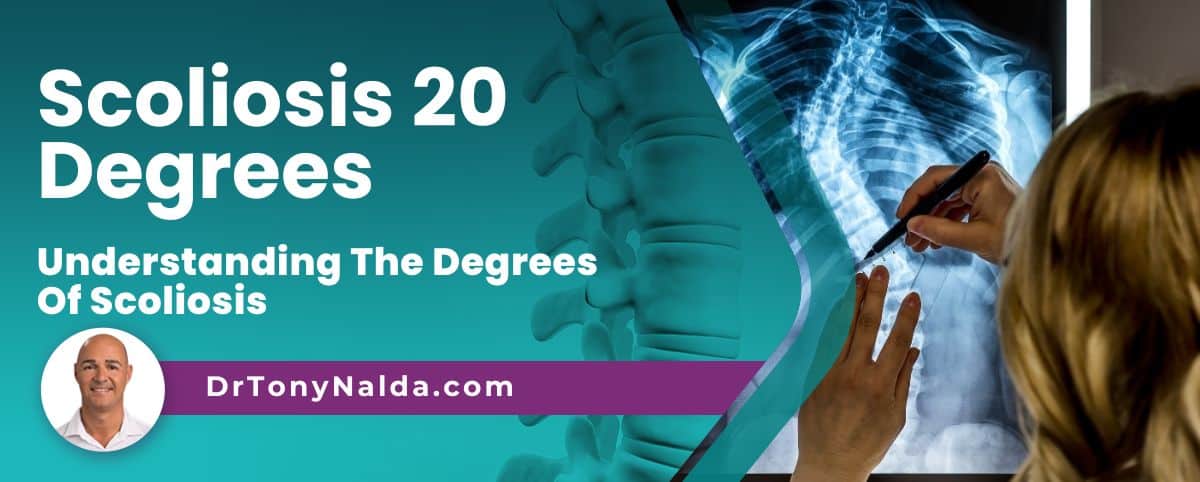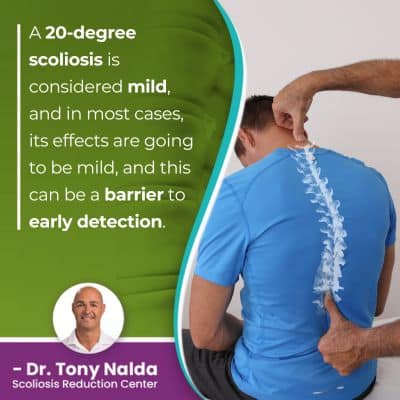Scoliosis 20 Degrees: Understanding The Degrees Of Scoliosis

There are many conditions and patient variables that shape a person's life with scoliosis, and when it comes to the degree of scoliosis, this refers to the size of the unnatural sideways-bending and rotating spinal curve. Regardless of a patient's severity, the best time to start scoliosis treatment is always now; continue reading to find out why.
There are different severity levels of scoliosis ranging from mild to moderate and severe to very severe. A patient's Cobb angle measurement determines severity, and a Cobb angle of 20 degrees would be considered mild scoliosis.
As a progressive condition, where a scoliosis is at the time of diagnosis doesn't mean that's where it will stay, so let's start with how scoliosis is diagnosed.
Table of Contents
How is Scoliosis Diagnosed?
Scoliosis causes the spine to develop an unnatural side-to-side spinal curve that also rotates, making it a complex 3-dimensional condition.
Scoliosis is diagnosed through a combined physical examination that involves taking the patient's family and medical history, performing an Adam's forward bend test, and confirming what's happening in and around the spine with a scoliosis X-ray.
An Adam's forward bend test involves patients bending forward at the hips as their spines are the most visible in this position, as are any related trunk asymmetries, and if this screening exam shows indicators of scoliosis, further testing is warranted.
A scoliosis X-ray is needed to reach an official diagnosis of scoliosis to confirm there is a rotational component and the patient's Cobb angle measurement; a minimum Cobb angle measurement of 10 degrees is needed to be considered a true scoliosis.
So as condition severity is determined by a patient's Cobb angle measurement, let's talk about the process.
Cobb Angle Measurement and Condition Severity
A patient's Cobb angle measurement is needed to reach a diagnosis of scoliosis and to classify conditions based on severity.
A patient's Cobb angle is determined during X-ray by drawing lines from the tops and bottoms of the curve's most-tilted vertebrae; the resulting angle is expressed in degrees, and the higher a patient's Cobb angle, the further out of alignment the spine is, and the more severe the condition:
- Mild scoliosis: Cobb angle measurement of between 10 and 25 degrees
- Moderate scoliosis: Cobb angle measurement of between 25 and 40 degrees
- Severe scoliosis: Cobb angle measurement of 40+ degrees
- Very-severe scoliosis: Cobb angle measurement of 80+ degrees
So a Cobb angle measurement of 20 degrees would mean a diagnosis of mild scoliosis, and this is where I can make the biggest impact with treatment because it's still early in the condition's progressive line.
As a progressive condition, the nature of scoliosis is to get worse over time; only proactive treatment can work towards counteracting the condition's progressive nature.
The more severe a condition, the more noticeable its effects are likely to be, and as a condition progresses, the size of the unnatural spinal curve is increasing, as are the condition's uneven forces, and their effects.
So what are the effects of mild scoliosis?
Understanding Mild Scoliosis
 A 20-degree scoliosis is considered mild, and in most cases, its effects are going to be mild, and this can be a barrier to early detection.
A 20-degree scoliosis is considered mild, and in most cases, its effects are going to be mild, and this can be a barrier to early detection.
In children, for whom the condition isn't commonly painful and postural changes can be subtle, mild scoliosis also isn't known to cause noticeable functional deficits so can be difficult to detect.
In fact, here at the Scoliosis Reduction Center, the majority of my scoliosis patients are diagnosed with moderate scoliosis because it's often after conditions have progressed from mild to moderate that condition effects are noticeable enough to lead to a diagnosis.
While there are never treatment guarantees, conditions that are diagnosed and treated early tend to respond better, and it can be far more effective to proactively work towards preventing progression and increasing effects than it is to attempt to reverse effects once they're established.
As there are different types of scoliosis, and adolescent idiopathic scoliosis is the most prevalent, this is the type we'll focus on for our current purposes.
Understanding the effects of mild scoliosis means awareness, and awareness can lead to early detection, and early detection is associated with treatment, so let's talk about the early signs of mild scoliosis.
Even when mild, scoliosis is introducing uneven forces to the body, and those uneven forces have the effect of disrupting the body's overall symmetry, so the condition's earliest signs are often postural changes:
- Uneven shoulders
- Uneven shoulders blades
- The development of a rib cage arch
- Uneven hips
- Arms and legs that seem to be different lengths
In addition to postural changes, the condition's uneven forces can also disrupt balance, coordination, and gait, but these effects tend to be subtle at the mild level and can be difficult for anyone other than a scoliosis specialist to recognize.
In addition, scoliosis doesn't become a compressive condition until skeletal maturity has been reached, and compression of the spine and its surrounding muscles and nerves is the main cause of condition-related pain, so in children, scoliosis doesn't cause a lot of noticeable back and nerve pain: another barrier to early detection and intervention.
Mild Scoliosis Treatment
When a patient is diagnosed with mild scoliosis, they are not going to feel fortunate, but I explain that it's hugely beneficial to be diagnosed while still mild as there are fewer limits to what can be achieved when treatment is started while conditions are still mild.
A spine with mild scoliosis is going to have a small curve that's simpler to treat, hasn't experienced significant progression so condition effects are also going to be mild, and is going to be flexible and more responsive to treatment.
 The way a diagnosis of mild scoliosis is responded to with treatment will shape the spine's long-term spinal health and function; there are different ways to treat scoliosis that affect the spine differently.
The way a diagnosis of mild scoliosis is responded to with treatment will shape the spine's long-term spinal health and function; there are different ways to treat scoliosis that affect the spine differently.
The two main scoliosis treatment approaches for patients to choose between are traditional and conservative.
Traditional scoliosis treatment commonly recommends that patients with mild scoliosis do nothing; they are told to watch and wait for signs of continued progression, but as a progressive condition, virtually every case will get worse at some point, so merely observing is wasting valuable treatment time.
It's important for patients to understand what triggers scoliosis to progress, and that's growth, so particularly for young patients going through rapid and unpredictable growth spurts, doing nothing can be dangerous.
The truth is that traditional scoliosis treatment doesn't have a strategy for addressing scoliosis while mild so waits for conditions to progress to a certain point (severe with a Cobb angle measurement of 40+ degrees), and then recommends invasive spinal fusion surgery; the issue I have with this is that had treatment been applied earlier, the condition might never have become severe enough to require scoliosis surgery.
Fortunately, there is a less-invasive nonsurgical treatment response that has proven results: modern conservative scoliosis treatment.
Conservative mild scoliosis treatment is started as close to the time of diagnosis as possible because this is when it's likely to be the most responsive and the simplest to treat.
Particularly when it comes to treating childhood scoliosis, starting treatment early and seeing results can be highly motivating for young people to stay committed to their course of treatment.
Here at the Center, conservative treatment integrates condition-specific chiropractic care, physical therapy, scoliosis-specific exercises, corrective bracing, and rehabilitation.
Conclusion
While there are no treatment guarantees, curve progression can be managed effectively with proactive treatment, and when a 20-degree scoliosis is diagnosed, the patient is living with mild scoliosis.
It's important for patients to understand, however, that being diagnosed with mild scoliosis doesn't mean it will stay mild; scoliosis ranges from mild to moderate severe to very-severe scoliosis, and these severity levels are also the condition's progressive line.
A scoliosis curve that's 20 degrees is just under the threshold for a moderate scoliosis classification at between 25 and 40 degrees, but if proactive treatment is applied as close to the time of diagnosis as possible and is successful, it may mean the patient's scoliosis stays mild.
The earliest telltale signs of mild scoliosis in children are postural changes such as uneven shoulders and hips, and in adults, the main symptom of scoliosis is pain; this is due to the condition becoming compressive once skeletal maturity is reached.
The most important thing to understand about a diagnosis of mild scoliosis at 20 degrees is that proactive treatment is needed to counteract the condition's progressive nature, and surgical intervention isn't always the best choice, particularly when it comes to long-term spinal health and function.
Dr. Tony Nalda
DOCTOR OF CHIROPRACTIC
After receiving an undergraduate degree in psychology and his Doctorate of Chiropractic from Life University, Dr. Nalda settled in Celebration, Florida and proceeded to build one of Central Florida’s most successful chiropractic clinics.
His experience with patients suffering from scoliosis, and the confusion and frustration they faced, led him to seek a specialty in scoliosis care. In 2006 he completed his Intensive Care Certification from CLEAR Institute, a leading scoliosis educational and certification center.
About Dr. Tony Nalda
 Ready to explore scoliosis treatment? Contact Us Now
Ready to explore scoliosis treatment? Contact Us Now





